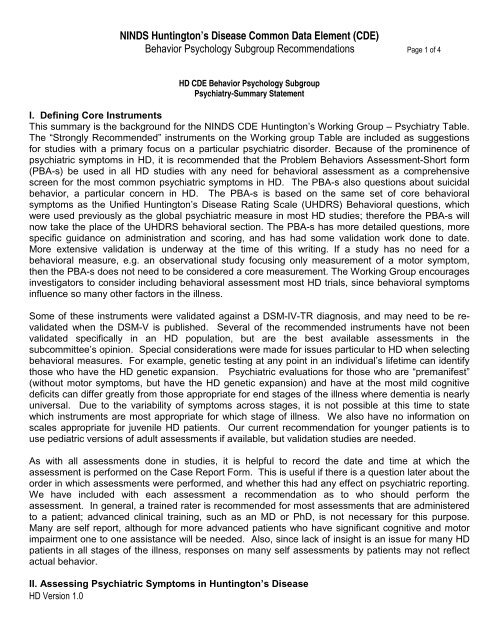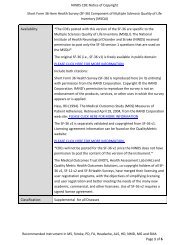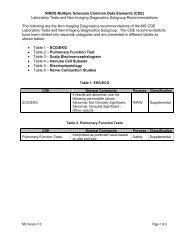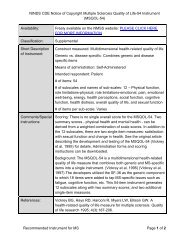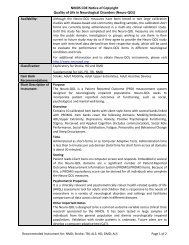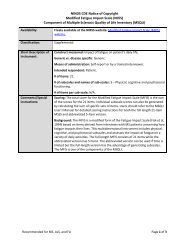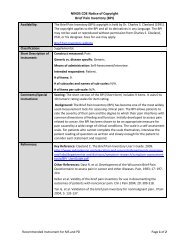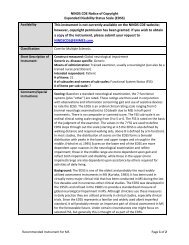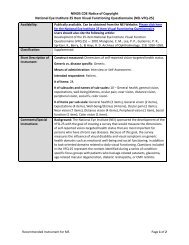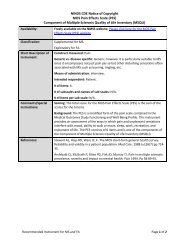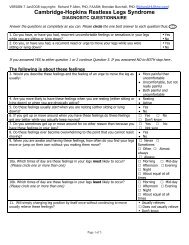NINDS CDE Huntington's Disease Behavioral Psychology Subgroup ...
NINDS CDE Huntington's Disease Behavioral Psychology Subgroup ...
NINDS CDE Huntington's Disease Behavioral Psychology Subgroup ...
You also want an ePaper? Increase the reach of your titles
YUMPU automatically turns print PDFs into web optimized ePapers that Google loves.
<strong>NINDS</strong> Huntington’s <strong>Disease</strong> Common Data Element (<strong>CDE</strong>)Behavior <strong>Psychology</strong> <strong>Subgroup</strong> Recommendations Page 4 of 4symptoms often do not feel shame or anxiety in connection with their behaviors. This can significantlylimit ability to score impairment on assessments due to obsessive/compulsive symptoms. There areno good scales available for perseveration. The PBA-s interview question on perseveration providesguidance on how to assess perseveration clinically. This is an area with definite research needs in thefuture.C. ApathyApathy is a common syndrome in HD. It is the one psychiatric symptom that generally progresseswith advancement of neurological disease. Distinguishing apathy from depression can pose a seriouschallenge in HD, both in clinical evaluation and when using assessment tools. Presence of apathycan impair ability to report other psychiatric symptoms.D. Irritability- Irritability is another common symptom in HD. It can be seen very early in the condition.Assessment of irritability often requires input from an informant, due to lack of insight by patients.The PBA-s has questions on both irritability and angry/aggressive behavior.E. Psychosis/paranoia- these symptoms are less common in HD. If they occur abruptly, evaluationfor underlying medical illness is warranted. There are no scales with a good representation of the typeof paranoia seen in HD. The PBA-s does have an item on assessment of paranoid and delusionalthinking, and another on hallucinations.F. Sleep Disorders- Sleep problems are common in HD and a variety of sleep problems are seenclinically including latency of sleep onset, frequent awakenings, decreased total sleep time andreversal of circadian rhythms. Few studies to date have systematically examined sleep in HD andeven fewer have used formal sleep measures. We recommend two sleep measures as supplemental,the SCOPA-SLEEP and the Pittsburgh Sleep Quality Index (PSQI). The Cambridge Brain RepairCentre HD Sleep Questionnaire is a new screening instrument specifically developed to assess sleepproblems in Huntington’s disease, but its psychometric properties have not yet been published; thus, itis recommended as an exploratory measure.HD Version 1.0
<strong>NINDS</strong> <strong>CDE</strong> Huntington’s <strong>Disease</strong> <strong>Behavioral</strong> <strong>Psychology</strong> <strong>Subgroup</strong>Recommended <strong>CDE</strong>’s Page 2 of 2Type of Instrument Instrument Core? CommentsObsessive/CompulsivePerseverative1) Padua-Inventory-OCD-Wash-U-Revised2) Florida ObsessiveCompulsive Inventory1) No2) NoIrritability 1) Irritability Scale 1) Core only if Irritability ismain focus.Sleep1)Scale for Outcomes of 1) NoParkinson’s disease- Sleep2) Pittsburgh Sleep Quality 2) NoIndex3) Cambridge Brain Repair 3) NoCentre (BRC) HD SleepQuestionnaireThere are no good scales for the type of O/C and Perseverativesymptoms seen in HD- this is an area of research need.This is the only irritability scale with significant data in HDpopulations to support its use.There are no good scales for evaluation of sleep disorders inHD. This is an area of research need.Psychosis None There are no good scales for psychotic symptoms seen in HD,this is an area of research need.HD Version 1.0
Description of Apathy Evaluation Scale forHD Common Data ElementsInstrument Name:Classification:Short Description ofInstrument:ScoringMeasurementsPsychometricPropertiesApathy Evaluation ScaleCoreSummary/ Overview of Instrument: Semi-structures interview with 18 questionsassessing apathy in the past four weeks. This scale was originally designed forpatients with Parkinson’s disease or Alzheimer’s disease.Construct measured: ApathyGeneric vs. disease specific: GenericIntended use of instrument/ purpose of tool: Assessment of severity of apathyMeans of administration: Paper and pencilLocation of administration: Clinic or homeIntended respondent: Patient/self (AES-S), Informant (AES-I) and Clinician(AES-C) version# of items: 18# of subscales and names of sub-scales: NoneScoring: Rating of each item is based on a semi-structured interview. Theinterview should begin with a description of the subject’s interest, activities anddaily routine. The items should be anwered based on the subject’s thoughts,emotions, and actions; based on both verbal and non-verbal information of thepast 4 weeks. For each item ratings should be judged: 4 possible responses foreach question: ‘not at all’, ‘slightly’, ‘somewhat’, ‘a lot’.Standardization of scores to a reference population (z scores, T scores, etc):Not availableIf scores have been standardized to a reference population, indicate frameof reference for scoring (general population, HD subjects, other disease groups,etc). Not availableType of scale used to describe individual items and total/subscale scores:ContinuousReliability:Test-retest or intra-interview (within rater) reliability: AES-S = 0.76; AES-I = 0.94;AES-C = 0.88Inter-interview (between-rater) reliability (as applicable): Inter-rater reliability wasonly tested for the AES-C and w as found to be go od (intraclass correlationcoefficient = 0.94 (Marin, 1991).Internal consistency: Coefficient alpha: AES-S = 0.86; AES-I = 0.94; AES-C =0.90HD Version 1.0 Page 1 of 2
Description of Apathy Evaluation Scale forHD Common Data ElementsRationale/Justification (includeany information onlanguage andcountries/ cultures/ethnic groups wheretested)References:Statistical methods used to assess reliability:Validity:Content validity: not available in reviewed referencesConstruct validity: not available in reviewed referencesConvergent validity: Intercorrelations among the three scales (AES-S, AES-I, AES-C): AES-C and AES-I: r = 0.62; AES-C and AES-S: r = 0.72; AES-S andAES-I: r = 0.43.Sensitivity to Change/ Ability to Detect Change (over time or in response toan intervention): Not available in reviewed referencesKnown Relationships to Other Variables: Depression and use of medication(especially neuroleptics, antidepressants, and benzodiazepines) are related toapathy.Diagnostic Sensitivity and Specificity, if applicable: Not available in reviewedreferencesStrengths: This instrument assesses multiple aspects of apathy and has beenused in a variety of neuropsychiatric disorders, and allows for comparisonbetween patient/self, informant, and clinician reports.Weaknesses: The AES may not discriminate apathy from depression.Availability (copyright): http://www.dementia-assessment.com.au/symptoms/Special Requirements for administration: NoneAdministration Time: Likely 15-30 minutesTranslations available: Available in English, German, Dutch, French, SpanishKey Reference: Marin RS, Biedrzycki RC, Firinciogullari S: Reliability and validityof the Apathy Evaluation Scale. Psychiatry Research 1991;38:143-162HD Version 1.0 Page 2 of 2
Description of Apathy Scale forHD Common Data ElementsInstrument Name:Classification:Short Description ofInstrument:ScoringMeasurementsPsychometricPropertiesApathy ScaleCoreSummary/ Overview of Instrument: The Apathy Scale is an abridged version ofthe Apathy Evaluation Scale (Marin, 1990). The AS consists of 14 items regardingdifferent dimensions of apathetic behavior. The score for each item ranges from 0to 3. Rating of each item is based on a semi-structured interview: each questionshould be read by the examiner, and the patient is provided with the four possibleanswers.Construct measured: ApathyGeneric vs. disease specific: GenericIntended use of instrument/ purpose of tool: Assessment of severityMeans of administration: Paper and PencilLocation of administration: Clinic or at homeIntended respondent: Patient/self and informant# of items: 14# of subscales and names of sub-scales: NoneScoring: Ratings should be based on both verbal and non-verbal information ofthe past 4 weeks (sometime 2 weeks!). For each item ratings should be judged: 4possible responses for each question: ‘not at all’, ‘slightly’, ‘somewhat’, ‘a lot’.With a c utoff score of 14 points a s ensitivity 66% and s pecificity of 100% hasbeen reported in patients with Alzheimer’s disease.Standardization of scores to a reference population (z scores, T scores, etc):Not availableIf scores have been standardized to a reference population, indicate frameof reference for scoring (general population, HD subjects, other disease groups,etc). Not availableType of scale used to describe individual items and total/subscale scores:ContinuousReliability:Test-retest or intra-interview (within rater) reliability: The AS showed testretestreliability (r = 0.90, df = 10, p < 0.01) (Starkstein, 1992)Inter-interview (between-rater) reliability: The AS showed good interraterreliability (r = 0.81, df = 10, p < 0.01) (Starkstein, 1992). Inter-interview (betweenrater)reliability (as applicable): Interrater agreement for the presence of apathyabove a m edian score in a H D population ranged from poor for the mostcognitively impaired subjects to good for the less cognitively impaired subjectsHD Version 1.0 Page 1 of 2
Description of Cambridge Brain Repair Centre (BRC) HD Sleep Questionnaire forHD Common Data ElementsInstrument Name:Classification:Short Description ofInstrument:ScoringCambridge Brain Repair Centre (BRC) HD Sleep QuestionnaireExploratorySummary/ Overview of Instrument: A newly created instrument specificallydesigned for use with HD patients, this questionnaire was, in part, based onrecent questionnaires used in Parkinson’s disease. It contains 45 questions thatfocus on many aspects of sleep: duration, quality, quality of life, and abnormalsleep behaviors. The authors group the questions into four themed subcategories:quality of sleep, motor activity, abnormal nocturnal behavior and other aspects ofdisturbed sleep. T he authors of this instrument have written comprehensivereviews of the literature in HD and have conducted prior studies of sleep in HD.Construct measured: The total score is conceptualized as a measure of “sleepdisturbance”, but individual questions address a broad range of sleep problemsGeneric vs. disease specific: Developed specifically for Huntington’s diseasepopulations, though the questions do not specifically mention HD such that itcould potentially be studied for possible use in other populations.Intended use of instrument/ purpose of tool: To date the instrument has onlybeen used in one cross-sectional study (primary reference) but the authorssuggest that it might be useful in longitudinal studies. It is primarily proposed as ascreen for sleep disturbance.Means of administration: Paper and pencilLocation of administration: Clinic or homeIntended respondent: Patient# of items: 45# of subscales and names of sub-scales: NoneScoring: A total sleep disturbance score is calculated using a number (but not all)of the questions in the questionnaire. The questions that count toward the totalscore were, in part, selected as they distinguished HD patients from controls inthe primary reference study. A scoring sheet is appended to the original paperwhich identifies the items that count toward the total score as well as the pointsassigned to various options. Scores range from 0-19 and the authors recommendthe following subgroup classifications: normal (0-3), mild (4-6) and s ignificantsleep disturbance (7 and greater) with significant sleep disturbance being theclassification that warrants further investigation and/or treatment when used as ascreening measure in clinical settings.Standardization of scores to a reference population (z scores, T scores, etc):Insufficient researchHD Version 1.0 Page 1 of 3
Description of Cambridge Brain Repair Centre (BRC) HD Sleep Questionnaire forHD Common Data ElementsMeasurementsPsychometricPropertiesRationale/Justification (includeany information onlanguage andcountries/ cultures/ethnic groups wheretested)If scores have been standardized to a reference population, indicate frameof reference for scoring (general population, HD subjects, other disease groups,etc). Scoring was developed specifically for HD subjectsType of scale used to describe individual items and total/subscale scores:Some questions are ordinal, others are dichotomous (yes/no)Reliability: The primary reference study statistically tested for differences inindividual questions and total scores between subject group (HD, carersand controls) but no analysis of the psychometric properties of this newinstrument was reported to determine its reliability.Test-retest or intra-interview (within rater) reliability (as applicable): Not availableInter-interview (between-rater) reliability (as applicable): Not availableInternal consistency: Not availableStatistical methods used to assess reliability: Not availableValidity: While a number of questions effectively distinguished between anHD group and controls, no analyses of validity were reported in the primaryreference study.Content validity: Not availableConstruct validity: Not availableSensitivity to Change/ Ability to Detect Change (over time or in response toan intervention): UnknownKnown Relationships to Other Variables (e.g. gender, education, age, etc):UnknownDiagnostic Sensitivity and Specificity, if applicable (in general population, HDpopulation- premanifest/ manifest, other disease groups): Not intended fordiagnosis of specific sleep disorders, but rather for clinical screening for sleepdisturbance in Huntington’s disease.Strengths: Specifically designed to screen for sleep disturbances in HD, simpleto administer and briefWeaknesses: Psychometric properties (internal consistency, test-retestreliability, inter-interview reliability, contruct validity) are unknown at present.Other than the primary reference study, no studies to date have used thisinstrument so that comparisons cannot be m ade with the literature of otherpopulations. The sleep disturbance score, while based on items that distinguishedHD patients and controls, may not be an effective measure for outcome studiesas many items are dichotomous (yes/no) and do not allow for gradations ofseverity.Availability (copyright): Free—appended to the original paper. D etails are notspecified, so contacting the authors for permission is recommended.Special Requirements for administration: NoneHD Version 1.0 Page 2 of 3
Description of Cambridge Brain Repair Centre (BRC) HD Sleep Questionnaire forHD Common Data ElementsReferences:Administration Time: Brief (approximately 5 minutes)Translations available: None knownKey Reference: Goodman AO, Morton AJ, Barker RA. Identifying sleepdisturbances in Huntington’s disease using a simple disease-focusedquestionnaire. PLoS Currents 2010; October 15. (Online access:http://www.ncbi.nlm.nih.gov/pmc/articles/PMC2957697/ )HD Version 1.0 Page 3 of 3
Description of Frontal Systems Behavior Scale forHD Common Data ElementsInstrument Name:Classification:Short Description ofInstrument:ScoringMeasurementsPsychometricPropertiesFrontal Systems Behavior Scale (FrSBe)SupplementalSummary/ Overview of Instrument: Formerly the Frontal Lobe PersonalityScale (FLOPS), the FrSBe was designed to identify and q uantify behavioralproblems associated with frontal lobe dysfunction. This scale assesses behaviorrelated to frontal systems damage. I t also quantifies behavioral changes overtime by including both baseline (retrospective) and current assessments ofbehavior. Forms are available for both patient and family member to complete,with separate norms for each informant. There is potential for discrepancybetween the information collected from the informant and the participant.Construct measured: Assesses behaviorGeneric vs. disease specific: GenericIntended use of instrument/ purpose of tool: Cross-sectional or longitudinalassessment of symptoms commonly seen in patients with ‘frontal’ disordersMeans of administration (paper and pencil, computerized): Paper and pencilLocation of administration: Clinic or home (self-report)Intended respondent: Patient and/or caregiver# of items: Apathy (14 items), Disinhibition (15 items), Executive Dysfunction (17items)# of subscales and names of sub-scales: 3 – Apathy, Disinhibition, ExecutiveDysfunctionScoring: Each item is rated on a 5-point Likert scale. Totals are generated foreach subscale and normative data is referenced (based on patient gender, ageand education) and s tandardized T scores are determined (mean: 50, SD:10).Interpretation of results require training and coursework in psychologicalassessment.Standardization of scores to a reference population (z scores, T scores, etc):Previously validated in patients with a variety of neuropsychiatric disorders.If scores have been standardized to a reference population, indicate frameof reference for scoring (general population, HD subjects, other disease groups,etc). Not availableType of scale used to describe individual items and total/subscale scores:OrdinalReliability:Acceptable based on normative sample data (Grace).HD Version 1.0 Page 1 of 3
Description of Frontal Systems Behavior Scale forHD Common Data ElementsRationale/Justification (includeany information onlanguage andcountries/ cultures/ethnic groups wheretested)Validity:Construct validity: Reviewed in manual and acceptable.Convergent validity with other behavioral measures was high (NPI, r=.64).Discriminant validity also good (Grace).Feasibility: Informants completing the Family Rating Form should have at leastweekly contact with the patient to ensure accurate behavioral observation.Patients must have cognitive capacity to read and complete the form.Factor structure: An exploratory principal component factor analysis using thefamily version with 324 neurological outpatients (mainly HD, PD and Alzheimer’sdisease patients) confirmed a f actor structure consistent with the subscalesoriginally proposed on theoretical grounds (Stout).Sensitivity to Change/ Ability to Detect Change (over time or in response toan intervention): This measure was designed in part to assess change overtime.Known Relationships to Other Variables: There have been no p ublishedreports of patients with manifest HD using the FrSBe, other than the factoranalysis referred to above (Stout). In the PREDICT-HD study, 745 mutationpositivesubjects, 163 mutation-negative control subjects and their companionscompleted subject and family versions respectively of the FrSBE (Duff). Mutationpositivesubjects reported more frontal behaviours than mutation-negativecontrols, even though most subjects were more than 10 y ears from predictedmotor onset. However, discrepancies between self-report and companion scoressuggested impaired insight in those closest to predicted disease onset. In non-HD studies, Apathy and Executive Dysfunction subscale scores are correlatedwith IADL’s (Grace), and the Disinhibition scale score is strongly related tocaregiver burden (Grace).Diagnostic Sensitivity and Specificity, if applicable: N/AStrengths: Assesses multiple domains of frontal lobe functioning and allows forcomparison of premorbid behavior with current status. Also allows for comparisonbetween patient and caregiver reports.Weaknesses: Large number of items may be a problem for more cognitivelyimpaired subjects. Scoring requires normative database and understanding of Tscores.Availability (copyright): Through Psychological Assessment Resources, Inc. Thismeasure is copyrighted and cannot be reproduced without permission.http://www4.parinc.com/Products/Product.aspx?ProductID=FRSBESpecial Requirements for administration: NoneAdministration Time: The scale takes 10 minutes to administer and 10-15minutes to score.HD Version 1.0 Page 2 of 3
Description of Frontal Systems Behavior Scale forHD Common Data ElementsTranslations available: Not available.References: Key Reference: Grace J, Malloy PF. Frontal Systems Behavior ScaleProfessional Manual. Lutz, FL: Psychological Assessment Resources, Inc. 2001.Other References: Stout JC, Ready RE, Grace J, Malloy PF, Paulsen JS.Factor Analysis of the Frontal Systems Behavior Scale (FrSBe). Assessment2003; 10: 79-85.Duff K, Paulsen JS, Beglinger LJ et al. ‘Frontal Behaviors’ before the diagnosis ofHuntington’s disease and their relationship to markers of disease progression:evidence of early lack of awareness. J Neuropsychiatry Clin Neurosci. 2010;22(2): 196-207.HD Version 1.0 Page 3 of 3
Description of Hospital and Anxiety Depression Scale forHD Common Data ElementsInstrument Name:Classification:Hospital Anxiety and Depression Scale (HADS)SupplementalShort Description ofInstrument:Summary/ Overview of Instrument: The scale was designed to screen formood disorders in general (non-psychiatric) medical outpatients. It focuses onsubjective disturbances of mood rather than physical signs, and aims atdistinguishing depression from anxiety. Compared to other instruments scales, itfocuses on emotional aspects of anxiety disturbances, as opposed to somatic andcognitive symptoms.Construct measured: Anxiety and depressionGeneric vs. disease specific: GenericIntended use of instrument/ purpose of tool: Clinical Trials, ObservationalStudiesMeans of administration: Self- administeredLocation of administration: Clinic, home, telephoneIntended respondent: Patient# of items: 14 – Anxiety (7 items), Depression (7 items)# of subscales and names of sub-scales: 2 – Anxiety, DepressionScoring Scoring: Items are rated on a 4 -point Likert-type scale ranging from 0 t o 3,generating a scale range of 0 to 42 points, with higher scores representing greatersymptom severity. The anxiety subscale has 3 items that refer to panic and 4 togeneralized anxiety.MeasurementsPsychometricPropertiesAdd the A questions to get a score for anxiety and the D questions for depression.Scores of 0-7 indicate normal levels of anxiety and depression; 8-10 indicateborderline abnormal anxiety and depression levels and 11-21 suggest abnormallevels of anxiety and depression.Standardization of scores to a reference population (z scores, T scores, etc):Not available.If scores have been standardized to a reference population, indicate frameof reference for scoring (general population, HD subjects, other disease groups,etc). N/AType of scale used to describe individual items and total/subscale scores:OrdinalReliability:Internal consistency described for patients with cancer (Moorey et al 1991):Anxiety subscale Cronbach’s alpha = 0.93; Depression subscale alpha= 0.9. Inhealthy UK sample, internal consistency for Anxiety, Depression and Total scoresHD Version 1.0 Page 1 of 2
Description of Hospital and Anxiety Depression Scale forHD Common Data ElementsRationale/Justification (includeany information onlanguage andcountries/ cultures/ethnic groups wheretested)were 0.82, 0.77 and 0.86 respectively (Crawford et al 2001).Test-retest reliability for healthy sample: correlation for Depression scale= 0.92;Anxiety subscale 0.89 (Snaith & Zigmond, test manual)Validity:Concurrent validity established in a number of studies (see Snaith & Zigmond, testmanual).Sensitivity to Change/ Ability to Detect Change (over time or in response toan intervention): Not available.Known Relationships to Other Variables: HADS depression scoresdifferentiate between patients taking/ not taking antidepressants, a nd malepatients and older patents at time of diagnosis had higher HADS depressionscores; HADS anxiety scores differentiated between patients with and without apsychiatric history and those taking/ not taking antidepressants (Wicks et al 2007).HADS Depression scores correlated with limb impairment, overall disease severityscores and, also with Anxiety scores with impairment on domains of the SicknessImpact Scale (Goldstein et al 1998). Anxiety and depression subscale scorescorrelated with subscales of the Sickness Impact Scale; Depression subscalescores correlated with speech and mobility scores on t he Barthel Index andAnxiety scores correlated with Barthel speech items (Hogg et al 1994).Diagnostic Sensitivity and Specificity, if applicable (in general population, HDpopulation- premanifest/ manifest, other disease groups): Not available.Strengths: Serves as a good screening measure. H as been widely used.Relatively simple to complete.Weaknesses: This scale is not designed for HD; however, it is a quick screen.Requires insight to provide accurate reflection. No proxy verification.Availability (copyright): www.gl-assessment.co.ukSpecial Requirements for administration: NoneAdministration time: About 2-5 minutesTranslations available: Over 80 translations availableReferences: Key Reference: Zigmond AS and Snaith RP: The Hospital Anxiety AndDepression Scale. Acta Psychiatr Scand 1983, 67:361-70.Other References: Crawford, J. R., Henry, J. D., Crombie, C. & T aylor, E. P.Normative data for the HADS from a large non-clinical sample. British Journal ofClinical <strong>Psychology</strong> 2001; 40: 429–434.HD Version 1.0 Page 2 of 2
Description of Irritability Scale forHD Common Data ElementsRationale/Justification (includeany information onlanguage andcountries/ cultures/ethnic groups wheretested)References:Internal consistency: The Cronbach’s alphas were 0.90 for the IS-self and 0.93 forthe IS-inf (Reedeker, submitted).Statistical methods used to assess reliability: Kruskal-Wallis tests were conductedto compare IS-self and IS-inf scores (Reedeker, submitted).Validity:Content validity: Not availableConstruct validity: Not availableSensitivity to Change/ Ability to Detect Change (over time or in response toan intervention): The IS cut-off score of ≥ 14 points yielded an acceptablesensitivity and high specificity for all three cut-off points.Known Relationships to Other Variables: Use of medication.Diagnostic Sensitivity and Specificity, if applicable (in general population, HDpopulation- premanifest/ manifest, other disease groups): Not available.Strengths: Self report and Informant reportWeaknesses: Presence and severity are roughly scored on a 5-points likertscale.The cut-off score is not validated (no external validity).Availability (copyright): Available freelySpecial Requirements for administration: NoneAdministration Time: Likely 15-30 minutesTranslations available: Available in English, DutchKey Reference: Chatterjee A, Anderson KE, Moskowitz CB, Hauser WA, MarderKS: A comparison of self-report and caregiver assessment of depression, apathy,and irritability in Huntington’s disease. J Neuropsychiatry Clin Neurosci 2005; 17:378-383 [scoring of the IS in this article is incorrect]Other References: Klöppel S, Stonnington CM, Petrovic P, Mobbs D, Tüscher O,Craufurd D, Tabrizi SJ, Frackowiak RSJ: Irritability in pre-clinical Huntington’sdisease. Neuropsychologia 2010; 48: 549-557Reedeker W, Bouwens JA, Giltay EJ, Le Mair SE, Roos RAC, van der Mast RC,van Duijn E: Irritability in Huntington’s disease. submittedHD Version 1.0 Page 2 of 2
Description of Padua Inventory- Washington State University Revision forHD Common Data ElementsInstrument Name:Classification:Short Description ofInstrument:ScoringMeasurementsPsychometricPropertiesPadua Inventory – Washington State University RevisionSupplementalSummary/ Overview of Instrument: 39 item inventory of 5 factors in OCD.Construct measured: Obsessive Compulsive Disorder (OCD). Note thisrevision was done to ensure the scale was specific to OCD, and did not measureworry, which was an issue with the original Padua Inventory.Generic vs. disease specific: Generic OCD scale, not specific to HD.Intended use of instrument/ purpose of tool: Not specifiedMeans of administration: Paper and PencilLocation of administration: Clinic or home.Intended respondent: Patient# of items: 39 items# of subscales and names of sub-scales: 5 – Contamination Obsessions andWashing Compulsions; Dressing/Grooming Compulsions; Checking Compulsions;Obsessional Thoughts of Harm to Self/Others; Obsessional Impulses to HarmSelf/OthersScoring (include reference to detailed scoring instructions, including calculationof a total score and subscale scores, and any limitations of scale or scoring posedby item nonresponse): Each item is rated on a 5 -point scale according to thedegree of disturbance caused by the thought or behavior (0 = "not at all" to 4 ="very much"). S ubscales are simply scored by summing scores for all itemsincluded in the subscale.Standardization of scores to a reference population (z scores, T scores, etc):Burns et al, 1996 reference provides a t able with normative data on the PI--WSUR for the sample of 5010 individuals.If scores have been standardized to a reference population, indicate frameof reference for scoring (general population, HD subjects, other disease groups,etc). General populationType of scale used to describe individual items and total/subscale scores:OrdinalReliability:Test-retest or intra-interview (within rater) reliability (as applicable): test-retestcorrelation for the total PI-WSUR was 0.76 with the values for the 5 subscalesvarying from 0.61 for the OTAHSO subscale and 0.84 for the OITHSO subscale.Inter-interview (between-rater) reliability (as applicable): Not applicable- onlypatient reports symptoms on the scale.Internal consistency: Not available.HD Version 1.0 Page 1 of 2
Description of Pittsburgh Sleep Quality Index forHD Common Data ElementsInstrument Name:Classification:Short Description ofInstrument:ScoringPittsburgh Sleep Quality Index (PSQI)SupplementalSummary/ Overview of Instrument: A self-rated questionnaire that primarilyassesses nighttime sleep problems. I t focuses on sleep experiences over thepast month. It has 19 s elf-rated questions and 5 ad ditional questions for a bedpartner or roommate.Construct measured: Sleep quality, sleep habits and s leep disturbances.Seven component scores: subjective sleep quality, sleep latency, sleep duration,habitual sleep efficiency, sleep disturbances, use of sleeping medication, daytimedysfunctionGeneric vs. disease specific: Has been used in many different populations; it isnot disease specific.Intended use of instrument/ purpose of tool: Can be us ed as a s creeninginstrument for nighttime sleep disturbance or for clinical studies. It cannot beused to diagnose specific sleep disorders, but instead may help distinguish “good”versus “poor” sleepers.Means of administration: Paper and PencilLocation of administration: Clinic, HomeIntended respondent: Patient (with 5 supplemental questions for a bed partneror roommate)# of items: 24 (19 self-rated items, and 5 supplemental items to be rated by abed partner or roommate)# of subscales and names of sub-scales: 7 – Subjective sleep quality, sleeplatency, sleep duration, habitual sleep efficiency, sleep disturbances, use ofsleeping medication, daytime dysfunctionScoring: Seven component scores are calculated, each scored from 0 to 3, thetotal score ranges from 0 to 21, with higher scores indicating more severe sleepproblems in many areas. Scoring requires following closely a complex algorithmand is not a simple summation of answers. A cutoff of 5/6 for the total score isused in general populations to distinguish between “good” and “ poor” sleepers.Scoring can be time consuming.Standardization of scores to a reference population (z scores, T scores, etc):The PSQI scores are not standardized to a particular population but thisinstrument has been used in many different populationsIf scores have been standardized to a reference population, indicate frameof reference for scoring (general population, HD subjects, other disease groups,etc). (See above.) While the scores are not standardized to a particular referencepopulation, the cutoff of 5/6 for “good” versus “poor” sleepers was developed fromHD Version 1.0 Page 1 of 3
Description of Pittsburgh Sleep Quality Index forHD Common Data ElementsMeasurementsPsychometricPropertiesRationale/Justification (includeany information onlanguage andcountries/ cultures/ethnic groups wheretested)general population samples and thus it may not carry over as the best screeningcutoff for specific populations such as HD subjects.Type of scale used to describe individual items and total/subscale scores(nominal, ordinal, or [essentially] continuous): OrdinalIf ordinal or continuous, explain if ceiling or floor effects are to be expectedif the measure is used in specific HD <strong>Subgroup</strong>s. Unknown due to insufficientuse in HD populationsReliability:Test-retest or intra-interview (within rater) reliability (as applicable): The Pearsoncorrelation coefficient for test-retest reliability in a non-HD population was 0.87and is stable over time (Högl et al., 2010).Inter-interview (between-rater) reliability (as applicable): not available in reviewedreferencesInternal consistency: A Cronbach’s alpha of 0.72 was found in a o ne HD study(Aziz et al. 2010); Cronbach’s alphas of between 0.80 and 0.83 have beenreported for the PSQI in different studies of non-HD populationsStatistical methods used to assess reliability: (as above)Validity:Content validity: Not available in reviewed referencesConstruct validity: In the original study, the instrument successfully discriminatedbetween clinical populations of good sleepers (normal healthy controls) andpatients from a sleep evaluation clinic. In a HD sample, the measure correlatedhighly with another sleep measure, the SCOPA-SLEEPSensitivity to Change/ Ability to Detect Change (over time or in response toan intervention): UnknownKnown Relationships to Other Variables: Not available in reviewed referencesDiagnostic Sensitivity and Specificity, if applicable (in general population, HDpopulation- premanifest/ manifest, other disease groups): Not useful for diagnosisof sleep disordersStrengths: Extensive literature of its use in other populations. Includes a numberof questions for bed partners (though these are not comprehensive and are notused in the scoring.)Weaknesses: Primarily assesses nighttime sleep problems; wording might beconfusing; does not directly address changes in circadian rhythms (sleep timeshifting to the day and awake all night) that clinically is often observed in HDpatients; the wording of certain questions is likely problematic for patients with HDand measures other constructs such as mood or motivation, e.g., “during the pastmonth, how much of a problem has it been for you to keep up enough enthusiasmto get things done.” One study (Aziz et al., 2010) in an HD population found theHD Version 1.0 Page 2 of 3
Description of Pittsburgh Sleep Quality Index forHD Common Data ElementsReferences:SCOPA-S more internally consistent, and much easier to score and use than thePSQI. The scoring algorithm is unusually complex.Availability (copyright): Copyrighted. T he author, Dr. Buysse, should becontacted for permission to use the instrument. If used for commercial researchpurposes, the Office of Technology Management at the University of Pittsburgh(412-648-2206) must be contacted for licensing information.http://www.sleep.pitt.edu/content.asp?id=1484&subid=2316Special Requirements for administration: NoneAdministration Time: Likely 5-10 minutesTranslations available: It has been translated in over 56 languages, according tothe University of Pittsburgh Sleep Medicine Institute website where these versionscan be requested.Key Reference: Buysse DJ, Reynolds CF, Monk TH, Berman SR, Kupfer DJ.Psychiatry Research 1989;28:193-213.Other References: Videnovic A, Leurgans S, Fan W, Jaglin J, Shannon K.Daytime somnolence and nocturnal sleep disturbances in Huntington disease.Parkinsonism and Related Disorders 2009;15:471-4.Aziz NA, Anguelova GV, Marinus J, Lammers GJ, Roos RAC. Sleep andCircadian rhythm alterations correlate with depression and cognitive impairment inHuntington’s disease. Parkinsonism and Related Disorders 2010;16:345-50.HD Version 1.0 Page 3 of 3
Description of Problem Behaviours Assessment for HD- short version forHD Common Data ElementsInstrument Name:Classification:Short Description ofInstrument:Problem Behaviours Assessment for HD – short version (PBA-s)CoreSummary/ Overview of Instrument: Brief semi-structured interview covering themost common behavioural and psychiatric manifestations of HDConstruct measured: The interview is not restricted to a single construct, butrather covers several broad symptom domains (affect, irritability, loss ofmotivation, perseverative phenomena and psychotic symptoms) relevant to HD.Generic vs. disease specific: Specific to HDIntended use of instrument/ purpose of tool: Cross-sectional or longitudinalstudies. The interview is focused on symptoms rather than diagnoses and doesnot make assumptions about the diagnostic significance of these symptoms in thepresence of organic brain disease (i.e.HD).Means of administration: Face to face semi-structured interview. Thesuggested approach is to complete the PBA-s with the companion and participanttogether. After completeing the scale the interviewer should speak with thecompanion without the participant present.Location of administration: Clinic or homeIntended respondent: Patient and knowledgeable informant (e.g. spouse orcaregiver) together; the informant should be briefly re-interviewed afterwards toelicit any additional information which could not be discussed openly in presenceof the patient.# of items: 11 items (low mood, suicidal ideation, anxiety, irritability,anger/aggressive behaviour, loss of motivation, perseverative thinking orbehaviour, obsessive-compulsive behaviours, paranoid thinking, hallucinations,behaviour suggestive of disorientation)# of subscales and names of sub-scales: The PBA-s has not been formallydivided up into subscales; however, principal components analysis of dataobtained with the original 40-item Problem Behaviours Assessment for HD (PBA-HD) in both English (Craufurd et al., 2001)and Dutch (Kingma et al., 2007)translations identified three main factors corresponding to affective symptoms,irritability and apat hy respectively. I t would therefore be reasonable to add thescores for low mood, suicidal ideation and anxiety to create a single ‘affect’ score,and to add the scores for irritability and anger to create a composite ‘irritability andaggression’ score, as was done in the TRACK-HD study (Tabrizi et al., 2009).HD Version 1.0 Page 1 of 3
Description of Problem Behaviours Assessment for HD- short version forHD Common Data ElementsScoringMeasurementsPsychometricPropertiesScoring: Each symptom is rated for severity on a 5 -point scale according todetailed scoring criteria which roughly correspond to the following: 0 = "not at all";1 = trivial; 2 = mild; 3 = moderate (disrupting everyday activities) and 4 = severeor intolerable. Each symptom is also scored for frequency on a 5-point scale asfollows: 0 = symptom absent; 1 = less than once weekly; 2 = at least once aweek; 3 = most days (up to and including some part of every day); and 4 = all day,every day. S everity and f requency scores are multiplied to produce an ov erall‘PBA score’ for each symptom. A lthough it would be pos sible to sum theindividual PBA symptom scores to derive an overall total score, it is unlikely thatthis is very meaningful.Standardization of scores to a reference population (z scores, T scores, etc):Not applicableType of scale used to describe individual items and total/subscale scores(nominal, ordinal, or [essentially] continuous): OrdinalIf ordinal or continuous, explain if ceiling or floor effects are to be expectedif the measure is used in specific HD <strong>Subgroup</strong>s: Significant ceiling effectswere observed in the TRACK-HD study (Tabrizi et al.); for most PBA symptoms,between 25% - 50% of pre-symptomatic HD mutation carriers scored zero forseverity on the more common PBA symptoms (e.g. low mood, anxiety orirritability) with a much higher proportion scoring zero for less common items suchas aggression, suicidal ideation or hallucinations.Reliability:Test-retest or intra-interview (within rater) reliability (as applicable): N/AInter-interview (between-rater) reliability (as applicable): inter-rater reliability wasmeasured in the TRACK-HD study by video-recording interviews and re-scoring ofa random sample by an expert rater. O verall unweighted kappa scores for theseverity ratings were 0.70 and for the frequency ratings, 0.77. Kappa scores inthe range 0.61 – 0.80 are usually considered to represent ‘substantial agreement’.Internal consistency: N/AStatistical methods used to assess reliability: Cohen’s kappa.Validity: Difficult to assess because of the lack of an alternative ‘gold standard’measure. T he selection of symptoms for inclusion in the measure, and thedevelopment of the detailed scoring criteria used, were carried out by a group ofexperts from the EHDN Behavioural Phenotype Working Group. T he range ofsymptoms covered by the measure is very similar to the behavioural section ofthe UHDRS, and the PBA-s is probably best thought of as the latest elaboration ofthe UHDRS behavioural interview.Sensitivity to Change/ Ability to Detect Change (over time or in response toan intervention): The longitudinal rate of change in PBA-s apathy scores over 24months’ follow-up was significantly greater in manifest HD subjects than incontrols (Tabrizi et al., manuscript under review). Analysis of the TRACK-HD 36-HD Version 1.0 Page 2 of 3
Description of Problem Behaviours Assessment for HD- short version forHD Common Data ElementsRationale/Justification (includeany information onlanguage andcountries/ cultures/ethnic groups wheretested)References:month longitudinal data is in progress.Known Relationships to Other Variables: A paper describing relationshipsbetween PBA-s scores and those obtained using other symptom-specificmeasures in the TRACK-HD study is in preparationDiagnostic Sensitivity and Specificity, if applicable (in general population, HDpopulation- premanifest/ manifest, other disease groups): Developed for use withmanifest HD populationStrengths: Obvious face validity (semi-structured interview covering the samecore behavioural symptoms as the UHDRS behavioural section); demonstratedexcellent inter-rater reliability in TRACK-HD study; suitable for use by allprofessionals familiar with HD (physician, psychologist, study nurse, etc.).Weaknesses: Investment of staff time for 25-minute interview; some trainingrequired.Availability (copyright): Available freelySpecial Requirements for administration: NoneAdministration Time: 20-25 minutesTranslations available: Available in English, Dutch, French, German, Norwegianand Spanish versions. Translation into other European languages in progress.Key Reference: A paper describing the reliability of the PBA-s (in English, Dutchand French) based on data from the TRACK-HD study is in preparation and willbe submitted shortly.Other References: Craufurd D, Thompson J, Snowden JS. Behavioural changesin Huntington’s disease: the Problem Behaviours Assessment. Neuropsychiatry,Neuropsychology and Behavioural Neurology 2001; 14 (4): 219-226.Kingma EM, van Duijn E, Timman R, van der Mast RC, Roos RAC. Behaviouralproblems in <strong>Huntington's</strong> disease using the Problem Behaviours Assessment.General Hospital Psychiatry 2008; 30: 155-161.Tabrizi SJ, Langbehn DR, Leavitt BR, Roos RAC, Durr A, Craufurd D, Kennard C,Hicks SL, Fox NC, Scahill RI, Borowsky B, Tobin A, Rosas HD, Johnson H,Reilmann R, Landwehrmeyer GB, Stout JC and the TRACK-HD Investigators.Biological and clinical manifestations of Huntington’s disease before and afterdiagnosis – the TRACK-HD study. Lancet Neurology 2009; 8 (9): 791-801. epub2009 July 29.HD Version 1.0 Page 3 of 3
Description of Scale for Outcomes of Parkinson’s disease-Sleep forHD Common Data ElementsInstrument Name:Classification:Short Description ofInstrument:ScoringScale for Outcomes of Parkinson’s disease – Sleep [SCOPA-SLEEP (SCOPA-S)]SupplementalSummary/ Overview of Instrument: The SCOPA-S (Scale for Outcomes ofParkinson’s disease-Sleep) is a self-rated questionnaire developed originally forresearch in Parkinson’s disease that addresses both nighttime sleep problemsand daytime sleepiness. Its questions focus on experiences over the past month.It has two questions on the use of sleeping medications, one question on anoverall global perception of sleep at night, 6 questions on sleep patterns at nightand 6 questions on sleep in the day.Construct measured: Two constructs are measured by its two subscales: 1.)Nighttime sleep problems (NS), and 2.) Daytime sleepiness (DS)Generic vs. disease specific: Developed for use in Parkinson’s diseaseresearch, but its questions do not refer at all to Parkinson’s disease with theoriginal intent for it to be potentially useful across other conditions. It has beenused in one study of Huntington’s disease patients and controls.Intended use of instrument/ purpose of tool: For research or clinicalpurposes—it could be used as a s creening instrument or for rating severity ofnighttime sleep disturbances or daytime sleepiness.Means of administration: Paper and PencilLocation of administration: Clinic or homeIntended respondent: Patient# of items: 14 (2 questions on use of sleeping tablets, 1 global perception ofsleep at night question, and the 11 items of the two subscales# of subscales and names of sub-scales: 2 – Nighttime sleep problems (NS:5items; score range:0-15), Daytime sleepiness (DS:6 items; score range 0-18)Scoring: With the exception of the one question on use of sleep medications inwhich the names of medications are listed with doses and frequency of use, all 13other items are Likert-type, with 4 to seven options such as “not at all,” “a little,”“quite a bi t,” and “ a lot.” All 11 questions from the two subscales, NS and DShave 4 o ptions which are scored 0-3. S ubscale totals are easily calculatedthough summing the totals of all items in that subscale.Standardization of scores to a reference population (z scores, T scores, etc):Insufficient research data to convert subscale scores to standardized scores,either with reference to normal population or manifest HD patients,presymptomatic gene carriers or controls.If scores have been standardized to a reference population, indicate frameof reference for scoring (general population, HD subjects, other disease groups,etc). Not available.HD Version 1.0 Page 1 of 3
Description of Scale for Outcomes of Parkinson’s disease-Sleep forHD Common Data ElementsMeasurementsPsychometricPropertiesType of scale used to describe individual items and total/subscale scores(nominal, ordinal, or [essentially] continuous): OrdinalIf ordinal or continuous, explain if ceiling or floor effects are to be expectedif the measure is used in specific HD <strong>Subgroup</strong>s. Unknown. (One study of itsuse in HD (Aziz, Anguelova, Marinus et al. 2010) used the measure in HDpatients, premanifest mutation carriers, bed partners and controls; the authors didnot report ceiling or floor effects in their small samples.)Reliability:Test-retest or intra-interview (within rater) reliability (as applicable): not assessedin HD populations, but good test-retest reliability in Parkinson’s diseasepopulation (intraclass correlation coefficients for NS 0.94, and DS 0.89 (Marinuset al, 2003)Inter-interview (between-rater) reliability (as applicable): Not assessed in HDpopulationsInternal consistency: Cronbach’s alpha for SCOPA-NS 0.89 and for SCOPA-DS0.85 in HD sample (Aziz et al.2010); in PD sample these values were 0.88 and0.91.Statistical methods used to assess reliability: (as above)Validity:Content validity: Not reported in reviewed referencesConstruct validity: found to correlate highly with other scales that measure similarconstructs: in HD subjects the NS subscale correlated highly with the PittsburghSleep Quality Index (r=0.77) in a small HD sample (Aziz et al., 2010) and the DSsubscale correlated highly with a m easure of daytime sleepiness, the EpworthSleepiness Scale (r=0.75).Sensitivity to Change/ Ability to Detect Change (over time or in response toan intervention): Unknown in HD populationsKnown Relationships to Other Variables (e.g. gender, education, age, etc):No known relationship to demographic variables in HD due t o paucity of datausing this instrument.Diagnostic Sensitivity and Specificity, if applicable (in general population, HDpopulation- premanifest/ manifest, other disease groups): Not appropriate fordiagnosis of sleep disorders; rather, it is useful for screening and formeasurement of the constructs of nighttime sleep problems and d aytimesleepinessHD Version 1.0 Page 2 of 3
Description of Scale for Outcomes of Parkinson’s disease-Sleep forHD Common Data ElementsRationale/Justification (includeany information onlanguage andcountries/ cultures/ethnic groups wheretested)References:Strengths: Easy to administer and to score. T he two subscales have beenshown in other populations to each measure one factor. The questions are clearand it is quite comprehensive. One small study in HD (Aziz et al 2010) found itmore reliable in HD patients than the Pittsburgh Sleep Quality Index or theEpworth Sleepiness Scale.Weaknesses: Limited use to date in the sleep literature of other populationscompared to other measures; does not directly address changes in circadianrhythms (sleep time shifting to the day and awake all night) that clinically is oftenobserved in HD patients. Aziz et al., 2010 suggested that one item in the DSsubscale “falling asleep while talking” may not be suitable for HD populations as itwas not endorsed by any of their subjects.Availability (copyright): Free, with permission of the authors, to all researcherswhether nonprofit or commercial. http://www.scopa-propark.eu/index.php?page=1&navRight=3&doc=3&group=Yes&taal=eng&language=eng&show=yesSpecial Requirements for administration: NoneAdministration Time: Short (less than 5 minutes)Translations available: A Spanish translation was studied in a p opulation ofParkinson’s disease patients. Unclear if other translations are available.Key Reference: Marinus J, Visser M, van Hilten JJ, Lammers GJ, StieggelboutAM. Assessment of Sleep and Sleepiness in Parkinson <strong>Disease</strong>. Sleep 2003;26:1049-54.Other References:Aziz NA, Anguelova GV, Marinus J, Lammers GJ, Roos RAC. Sleep andCircadian rhythm alterations correlate with depression and cognitive impairment inHuntington’s disease. Parkinsonism and Related Disorders 2010;16:345-50.Hogl B, Arnulf I, Comella C, et al. Scales to Assess Sleep Impairment inParkinson’s <strong>Disease</strong>:Critique and Recommendations. Movement Disorders2010;25:2704-16.HD Version 1.0 Page 3 of 3


